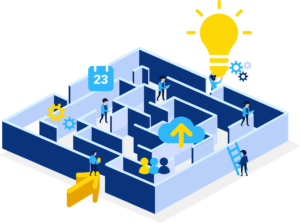Delivering an exceptional customer experience (CX) couldn’t be more important, as we note a steady decline in Customer in service levels it seems customer expectations are on the rise as running a contact centre becomes more challenging, high levels of attrition, multiple channels to manage and technology evolving faster then we can keep up with. s critical to success. In our Work with contact centres CX strategies aren’t always fully mature and having being thrown into an Omni channel cloud based and remote operational environment a lot sooner then they had planned thanks to covid, a lot of people are playing catch up.
The result is dissatisfied customers, disengaged employees, and inefficient operations. Moving from an immature to a more mature CX model requires addressing several key challenges , including poor customer outcomes, fragmented legacy systems, disengaged employees, poor performance management, clunky customer journeys, and inefficient operations. Let’s explore how contact centres can address these areas to build a more customer-centric, mature CX framework.
 1. Addressing Poor Customer Outcomes
1. Addressing Poor Customer Outcomes
Some contact centres often struggle with consistently delivering positive customer outcomes. Customer dissatisfaction arises from unresolved issues, lengthy resolution times, and lack of personalised service. To turn this around, contact centres must adopt data-driven strategies that allow for better understanding of customer needs and preferences. By leveraging data analytics and AI-powered tools, contact centres can anticipate customer needs, offer personalised solutions, and reduce resolution times. Additionally, implementing a closed-loop feedback system allows teams to learn from customer feedback and continuously improve service levels. Poor Customer outcomes are typically generated from from poorly defined processes, inadequately trained teams and a lack of continuous improvement agendas and poor measurement strategy and prioritisation of what matters and what’s important.
2. Overcoming Fragmented Legacy Systems
When the pandemic hit so many contact centres were thrust forward quite quickly into a cloud based and omni channel but also creating a more fragmented legacy of systems that prevent seamless communication and data sharing across departments. These outdated systems create silos, hinder real-time customer insights, and complicate agent workflows. To move toward maturity, contact centres should invest in cloud-based, integrated platforms that unify customer data, channels, and operations. A unified communications platform (UCP) provides a holistic view of each customer’s journey, enabling agents to access key information quickly, which results in faster, more informed responses.
 3. Engaging Disengaged Employees
3. Engaging Disengaged Employees
Employee engagement plays an important part of building a mature Customer Experience as motivated and engaged team members offer more discretionary effort and feel more connected to the vision, purpose and mission of the business so often go the extra mile for customers. Disengaged employees result in inconsistent service quality, higher turnover, and negative customer interactions. To boost engagement, contact centre leaders should focus on providing agents with the right tools, training, and support, getting the basics right and creating an environment where agents feel valued and comfortable to share ideas. Devising a regular skills builder and development programs, and reward scheme that recognises employee contributions, and promotes a positive work environment can significantly increase motivation and job satisfaction.
In addition, empowering agents with greater autonomy to resolve customer issues without constant escalation can lead to faster resolutions and increased agent satisfaction. Gamification, performance incentives, and collaborative tools can also create a more engaging and rewarding work experience.
4. Improving Performance and Quality Control
In our observations less mature contact centres often lack robust performance and quality control mechanisms. Without effective performance management, agents may struggle to meet key performance indicators (KPIs), and managers may have little visibility into operational efficiency. A mature CX model requires real-time performance tracking tools that provide insights into agent activities, customer interactions, and overall service quality. More mature contact centres invest in their leadership capability and build a structured coaching programme to support new and existing leaders to inspect what they expect. Training and Competence is a key aspect of maintaining Quality and performance standards and this means having a clear and structured knowledge base well defined Standard operating procedures.
Quality assurance programs can help standardise service delivery and identify areas for improvement. Regular audits of customer interactions, call recordings, and agent performance data can also provide actionable insights. Managers must have clear oversight and be able to offer timely coaching and feedback to agents, tools such as Speech Analytics and next best action and real-time agent guidance can be instrumental in supporting this and sign posting agents and team leaders to areas where they can improve and receive more targeted coaching feedback.
5. Streamlining Clunky Customer Journeys
A clunky, disjointed customer journey is a hallmark of an immature contact centre. Customers may experience multiple handoffs, long wait times, and inconsistent service across channels, which can lead to frustration and churn. To mature the CX strategy, contact centres should focus on optimising the customer journey from start to finish by mapping each touchpoint and identifying friction points. Inviting customers to input into the journey and identifying all of the aspects of the customer journey that cause friction will help build out a clear structured plan that can be tested. Using customer data to pin point the key areas in the customer journey that are most impactful such as retention, first year losses, conversion rates, service feedback all help to prioritise the key journey’s.
Adopting technology and omnichannel solutions that provide a seamless experience across channels—whether phone, email, chat, or social media—ensures that customers can interact with the business in their preferred method without losing context. With that said, making the options clearly visible and reducing the need for hand off is also an important aspect to consider with any new channels being delivered to ensure streamlined process smooth interactions and faster resolutions.

6. Enhancing Operational Efficiency
Operational is generally the most common issue we observe in our maturity assessments, inefficiency is a significant barrier to maturing the CX model in contact centres. Outdated processes, manual workflows, and inefficient use of resources can lead to longer resolution times, higher costs, and frustrated customers. Moving to a mature CX model involves looking at use of technology to automate repetitive tasks and using AI and machine learning to handle routine queries, allowing agents to focus on more complex issues. But the more fundamental task here is to kick the tyres of broken process and maximise the resources that you have.
So much time is lost to waste in the end to end process so taking a lean approach to process improvement and listening to your teams and analysing data and process flows can be a really beneficial exercise to build out a roadmap for continuous improvement. By adopting workflow automation, contact centres can reduce operational bottlenecks and optimize resource allocation. Additionally, establishing contact reasons and if those reason are value calls or driven by failure demand can help switch off demand or help deflect to AI, webchat or useful FAQ’s. Utilising Technology to intelligently route calls can help direct customer demand the right agent or department, reducing transfer times and improving first-call resolution rates.
Conclusion: Building a Mature CX Strategy
So turning an immature CX model into a mature one requires a clear plan, an understanding of the current realities and operational capabilities, it requires holistic approach that addresses customer outcomes, employee engagement, system integration, and operational efficiency. By investing in the right technologies, empowering employees and teams, streamlining processes, and ensuring quality control, contact centres can deliver exceptional customer experiences that drive loyalty and business success.
How mature is your Contact Centre? If you need help FAB Solutions are Contact Centre CX Specialists and we help contact centres find their baseline and then work with the to build and execute a plan to improve.
